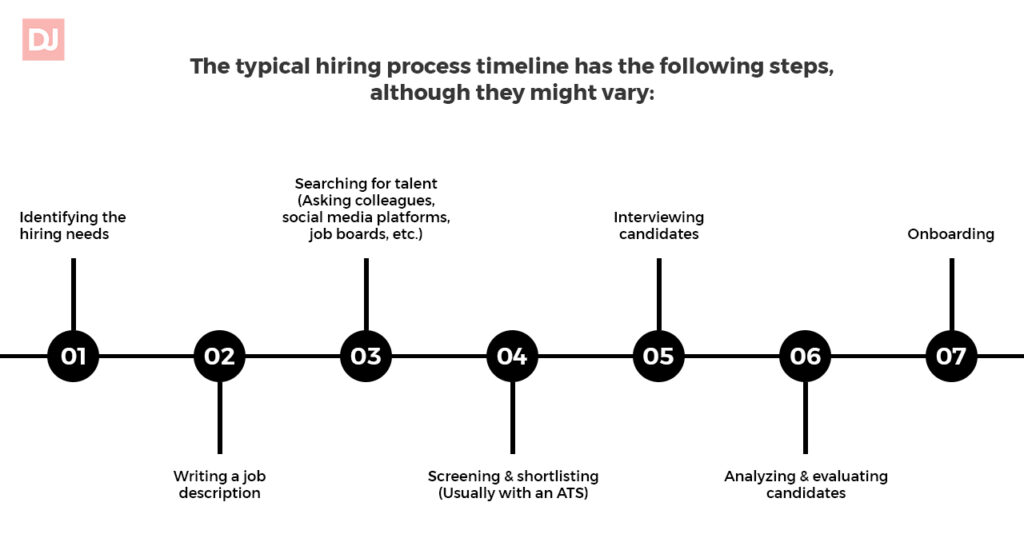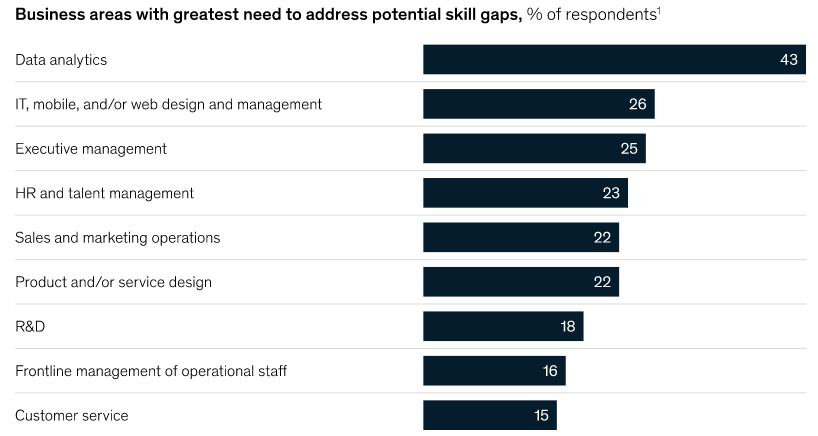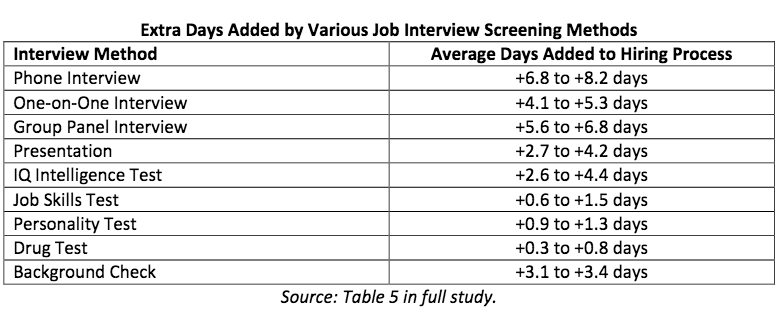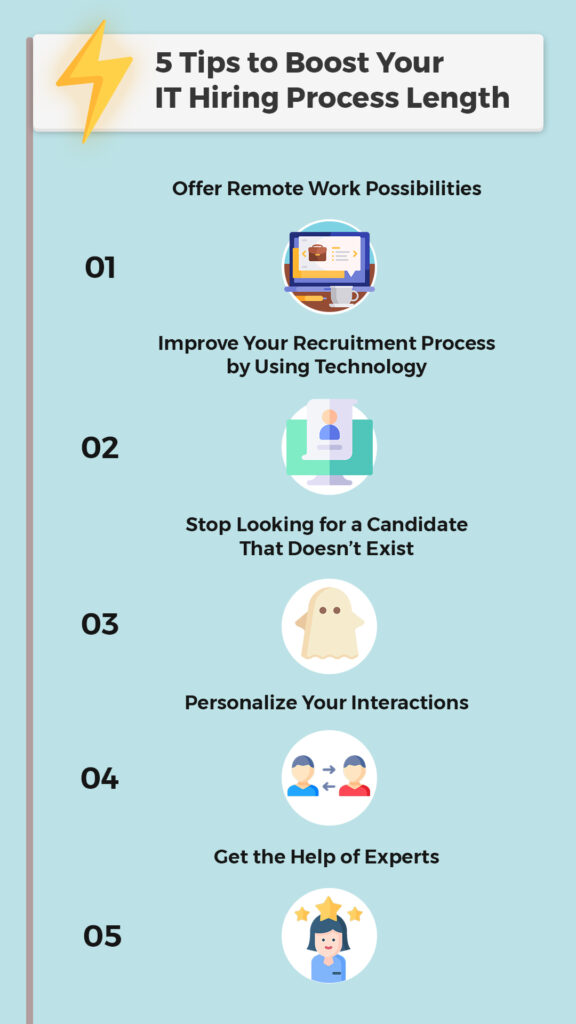Time is money. Wasting weeks and months due to the traditional IT hiring process length probably costs you more than you could imagine. And not necessarily because of time spent writing job descriptions or building an onboarding process. Often, companies get stuck in the interview and screening process, as they keep interviewing candidates who don’t have what it takes to fulfill the role. This leads them to continue an endless search for a candidate that usually doesn’t exist. Not only because of their high expectations but also because HR teams refuse to look beyond a certain geographical area.
The traditional IT hiring process length can last more than 50 days. What happens if you need to fill a role as soon as possible? Consider hiring remote.
What is the Process of IT recruitment?
The IT recruitment process involves finding and attracting potential tech candidates to fill vacant positions.
Usually, the IT recruitment process is conducted by hiring managers, the leader of the software development team, and recruiters. It involves finding the right candidate with the skills, requirements, and experience to perform in a determined position successfully.
In the IT industry, as it is one of the most competitive ones, IT recruitment is usually longer and more challenging than in other areas. Here, recruiters and HR teams need to be skilled enough to identify potential candidates and offer them a job opportunity they can’t refuse as most of the time, this is difficult because many candidates already have jobs.
The typical hiring process timeline has the following steps, although they might vary:

Traditional Recruitment Methods
Every company wants quality employees. But to get the desired talent, having a solid recruitment method is a must. With technology, the way companies recruit, especially when it comes to IT recruitment, has changed. We can now identify two types of recruitment methods: The traditional and the modern ones involving ATS, social media platforms, and IT headhunting.
The traditional recruitment methods have great strategies that have helped companies hire quality talent in the past years. This is why some companies, when looking to expand their software teams continue implementing them. Here are the most common traditional IT hiring processes:
- Newspapers—Many of us feel old to the idea of using physical newspapers. However, years ago, many people looked for jobs through newspapers. Companies looking to fill an IT position posted the announcement there in the hope that someone qualified would apply.
- Internal hiring – This is one of the most traditional IT hiring methods that continues to be popular nowadays. Internal hiring consists of filling vacancies from the existing workforce of a business.
- Local recruitment agencies—Hiring developers and other types of IT professionals is not easy, so companies choose to use local recruitment agencies, which already have a wide network of potential local candidates.
Why is the Traditional IT Hiring Process so Long?
The traditional IT recruitment length depends on every company. While it may be short and easy for some, it might take longer than expected for others. If the interview process in your company is particularly lengthy, it’s time to optimize some steps. On the other hand, if the recruitment process is too short and you have not had the best hires, this could mean that your team isn’t prioritizing several of the role’s skills and requirements.
The time to fill a vacancy depends on the industry, the role, the company, and the recruitment process, among other factors. On average, according to HireView, doing so takes between 14 and 63 days. Generally, employees needed to perform service positions (like waiting tables or customer service) can be filled within 10 days. Other industries and roles take longer.
For instance, for the IT industry in the U.S, time to fill is about 50 days on average.
IT recruitment length tends to be longer than that of other industries because IT is one of the most competitive ones. And as tech professionals are required in all industries, the developer shortage keeps increasing.
Korn Ferry shared that the current global shortage is of 40M skilled workers; by 2030 it is predicted to reach 85.2M workers. Companies could risk losing more than $4T in revenue because of the lack of skilled talent.
Here are the business areas with the greatest need to address potential skill gaps, according to a study conducted by McKinney:

Besides the threat of having a long and unsuccessful recruitment process because of talent shortage, companies are also behind the modern recruitment process. They continue using traditional recruitment processes, which most of the time consists in hiring onsite developers instead of moving along the latest recruitment trends. In other words, they don’t have a remote recruitment process.
Remote Hiring vs Traditional IT Hiring
Is the remote hiring process too different from the typical hiring process? For some companies, both processes are entirely different. For others, it depends on the role. Nowadays, most recruiting happens via social media platforms or job boards. However, the evaluation process is one of the most challenging parts of remote hiring.
Let’s evaluate the three core differences between remote IT hiring vs. traditional IT hiring:
Length
There is no precise statistic showing how remote hiring is faster than traditional hiring or vice versa. However, with our experience working in the IT field, helping companies hire remote IT employees has worked for us much faster than onsite because of one main reason: talent.
We noticed that the hiring process lasted almost 2 months in many companies. 2 months with a vacant position! And this was because they couldn’t find the candidate they needed and not because they were asking for an extravagant list of requirements, but because available candidates in the area didn’t have the needed skill set. Hiring remote candidates is faster as you have a wider pool of talent to choose from.
Cost
According to DevSkiller, companies can face a productivity loss of up to $33,251 while looking to fill a position. This is why having an effective recruitment process or working with recruitment agencies becomes even more valuable, as it guarantees you to have a skilled candidate in less than a month.
The cost of hiring a traditional developer vs. remote depends mostly on the location. If you live, let’s say in Eastern Europe or Asia, then you have higher chances of hiring a developer that has all the necessary skills and doesn’t charge an excessive salary. But if you don’t, you have three options:
- You spend a significant amount of money hiring an onsite developer.
- You hire someone who charges a low salary, but likely doesn’t have the needed experience.
- The third option, and the most reliable one, is to hire a remote developer. You look for a candidate with fluent English, the necessary skills, and experience. You only need to take care of having the tools to support this remote employee.
You might want to read: How Much Does It Cost to Hire a Python Developer? – Here’s the Global Python Developer Salary Guide
Screening
Another key difference between traditional hiring vs. remote hiring is screening. At this stage, recruiters want to find out if candidates are qualified enough to work at a company by reviewing their credentials, skills, and work experience.
While hiring remotely means you’ll have higher chances of getting more qualified and suitable applicants, it also means that you’ll have to refine your screening methods due to the number of applicants. You’ll need to have an ATS system and know how to vet remote talent, understanding if a candidate is or isn’t a good culture fit.
In a traditional setting, this seems easier because you meet the candidate in person, evaluate their body language and expression, and even evaluate their skills synchronously, whether by seeing them solve a specific problem or do a live test with you by their side.
In a remote setting, you need to understand the role you’ll be hiring for in depth to determine what methods will be most effective for evaluating candidates from a computer screen. If you don’t have any experience, this process can take you longer than expected.
The usual methods to evaluate developers are:
- Online coding tests on sites like HackerRank run anywhere from 15-45 minutes for candidates to complete, which is also followed by a review.
- Pair programming sessions that, according to Dice, can take about one working day per candidate.
- Take-home assignments, where you’ll have to allow a few days for the candidate to submit their work and an extra day to review.
Each additional step will add 4-8 extra days to the hiring process, says Glassdoor Economic Research:

5 Tips to Boost Your IT Hiring Process Length
Let’s say you started your recruitment process. You wrote an optimized, short but clear job description that contains everything an applicant needs to know. You publish it in all places you could think of, from job boards and social media platforms to ask your friends and family.
In a week, you start getting candidates that are interested in the role. Now, the interviewing and evaluation process begins. Weeks pass by, and while you interviewed the candidates, no one seemed the right one. Now, you have two choices:
- Settle for a ‘’Meh’’ candidate. The one that looks good enough to perform the role but not great enough to succeed at it.
The downside: Cost. While this really depends on your situation, keep in mind that a bad hire can cost you up to 30% of the employee’s first-year earnings, according to the U.S. Department of Labor.
- Keep looking until you find the right one.
The downside: Cost. While having an open position means you’re not paying a salary, it also means that you’ll end up losing a significant amount of revenue and productivity as the post remains vacant for too long.
What’s left? Are these the only two options you have? Of course not. As a leading remote recruitment agency, we know how to recruit developers in a blink of an eye. Literally. We help our clients hire a tech professional in just two weeks. How do we do this? Follow these tips:

1. Offer Remote Work Possibilities
Nowadays, everybody wants to work remotely. Although telecommuting was a reality for many companies like ours way before the pandemic, having multiple lockdowns all over the world made a massive difference to companies that had never considered it as an option. Now, because of this, most employees want to continue working remotely.
In a recent FlexJobs survey, 65% of respondents reported wanting to be full-time remote employees post-pandemic, and 31% want to work in a hybrid remote work environment. Furthermore, a different survey by insurance company Breeze found that 65% of Americans are willing to take a 5% pay cut to have the option to work remotely full-time.
The best strategy to attract candidates is to offer them what they want: remote work.
2. Improve Your Recruitment Process by Using Technology
Do you still use payphones? No, not unless you have no other option, right? With smartphones, it is easier than ever to access instant information, messages, and make calls. That’s why most of us have them, right? The same happens with your recruitment process. If you do the same things you have been doing for the last couple of years, you can’t expect different results.
Technology is your ally; use it as much as you can. Whether you still insist on hiring onsite developers, attracting, and interviewing candidates will be easier and faster with technology by your side. Some of the changes you can consider to enhance your recruitment process are:
- Using an Applicant Tracking System (ATS): ATS helps you have a better overview of candidates and faster and easier screening. Additionally, many of the manual tasks that take a lot of time, like scheduling interviews, for example, can all be automated with an ATS.
- Conducting remote interviews: Instead of having to go to a physical place, whether it’s the office or somewhere else, to conduct an interview, you could do it entirely via a video call application. It’s faster, and you still get to connect emotionally with candidates because you see their faces and expressions.
- Job advertising: Recruiters can take advantage of automation technology with programmatic job advertising. Automating placing your advertisement will help you target ideal candidates through the internet and save money on ads with a low (or none) return on investments. Overall, this can help recruiters reduce cost-per-applicant by over 30%.
3. Stop Looking for a Candidate That Doesn’t Exist
You’ve probably read a lot about the importance of having an ideal candidate with specific skills, personality traits, professional experience, etc. I always advise companies on the importance of knowing what they’re looking for in candidates and prioritizing specific skills. However, knowing the specific requirements of a candidate to develop in a role is one thing, and wanting to have the perfect candidate with no flaws is another.
If you have a huge list with all the requirements, academic background, certifications, skills, desires, personality traits, etc… Odds are you haven’t found that candidate because they simply don’t exist. I suggest you re-prioritize what you need in a candidate, keeping in mind these questions:
- What are the skills/certifications/abilities the candidate needs to perform the role?
- What are the desired skills you would value in a candidate?
- What personality traits do you consider are key for a candidate to blend in with your company culture?
- What could potential red flags in a candidate look like? (Examples include Generic answers, lack of eye contact (or screen), poor listening skills, etc.)
4. Personalize Your Interactions
This tip is especially for those leaders or recruiters that are starting to hire remote candidates. Always remember you’re talking to human beings, not robots. It often happens that the remote process seems very distant from candidates, that it can make some forget that they are dealing with human beings. This, consequently, impacts the candidate’s experience, which tells a lot about your company.
When interviewing candidates, prioritize understanding their needs and gathering the information that helps you form the right idea about them. If a candidate has great qualifications but perhaps has other job offers besides yours, understanding their needs and priorities will help you create a job offer they wouldn’t refuse.
5. Get the Help of Experts
If you want to speed up your traditional IT hiring process but are unsure of the best tools or how to hire developers, get the help of experts. Many recruitment agencies can help you hire the talent you need, as they usually have a wide network of thousands of potential candidates ready to start working for you.
Additionally, IT recruitment agencies speak the same language as candidates. If you need a Python developer, for example, they know what questions to ask and can tell if a candidate has in-depth knowledge of the subjects. Trying to do this without any technical expertise could lead you to hire the wrong candidate.
Contact DistantJob and Get Rid of the Traditional IT Hiring Process
At DistantJob, we’re a remote recruitment agency that specializes in tech talent. This means that we can help your company hire the best remote tech talent for you, 60% faster than the industry average.
Get rid of the traditional hiring process, and work with professionals like us. We focus on finding candidates with the exact skill set you need and on professionals who will adapt to your company’s culture and processes. We’re determined to find the very best talent for you, but we also focus on providing candidates with whom you’ll be glad to work every day.
If you want to know more about our innovative method and HR services, contact us!




